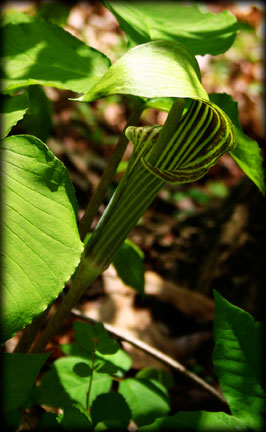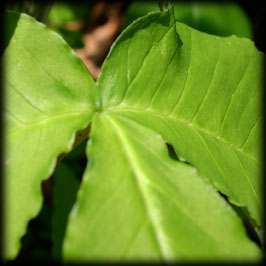Jack in the Pulpit
by Joshua Heston
A provocative find in the forest, this dragon arum makes us rethink what wildflowers are — and are not.
The blooms of the plant are hidden at the base of the spathe and spadix.
The spadex is “Jack” in his pulpit.
The plant’s leaflets closely resemble poison ivy.
In fall, the jack-in-the-pulpits die back, exposing knobby, red berries and a rather lonely looking stalk.
May 9, 2009
Jack in the Pulpit (Arisaema triphyllum)
Size: 1 to 3 feet tall; flower 1/8 inch long. What to look for: spathe with purpose and green stripes, hooded, enclosing club-like spadix (flowers clustered at base); leaves divided into 3 oval leaflets; berries red, clustered. Habitat: moist woods. In bloom: April through July.
— page 479, Wernett, Susan J., et al. North American Wildlife. The Reader's Digest Association, Inc., 1986.
From The Herbal Compendium:
Dragon Root. Arisaema triphyllum (Arum triphyllum)
Jack-in-the-Pulpit. Wild Turnip. Indian Turnip. Wake Robin.
Root: Diaphoretic. Stimulant. Acrid. Narcotic. Expectorant.
It is acrid, and used as an expectorant; it is also diaphoretic. it is used as well for lung diseases. The root should be used fresh, but must be partially dried, as it loses its strength with age (pg. 146).
Recommended internally in croup and low typhoid, and externally in scrofulous tumors and scald head (a Shaker term means scabs on the scalp) (pg. 155) [The plant] is violently irritating if improperly used by one unfamiliar with its peculiarities (pg. 186).
Shaker Medicinal Herbs: A Compendium of History, Lore and Uses by Amy Bess Miller
A word of safety: folk remedies on StateoftheOzarks are published for informational purposes only. These remedies are never intended to cure, treat or mitigate any disease or disease condition. For questions about disease or disease conditions, consult a qualified healthcare professional.

Plate 1. Jack-in-the-Pulpit (Arisaema triphyllum).

Plate 2.



